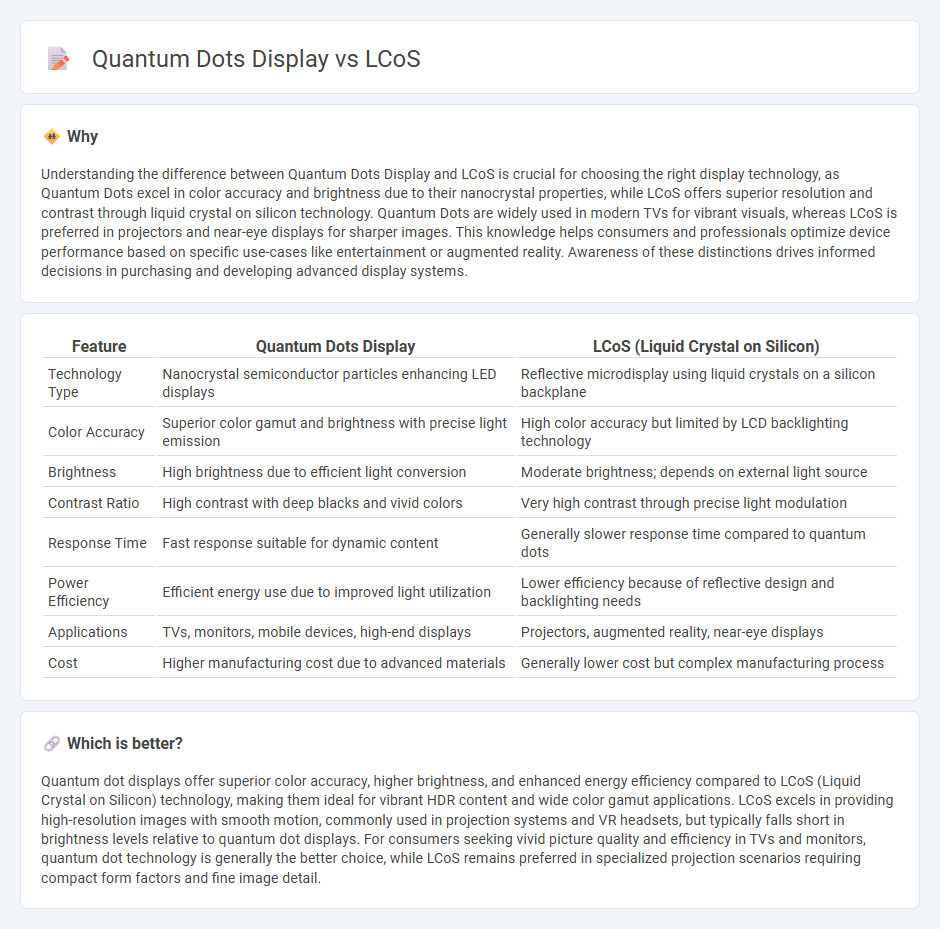
Quantum dots displays utilize semiconductor nanocrystals to produce precise, vivid colors and enhance brightness with superior energy efficiency, while LCoS (Liquid Crystal on Silicon) technology offers high-resolution images through reflective liquid crystals on a silicon backplane. Quantum dots excel in color accuracy and power consumption, whereas LCoS devices provide sharper image details ideal for projection systems and augmented reality applications. Discover more about how these advanced display technologies are transforming visual experiences.
Why it is important
Understanding the difference between Quantum Dots Display and LCoS is crucial for choosing the right display technology, as Quantum Dots excel in color accuracy and brightness due to their nanocrystal properties, while LCoS offers superior resolution and contrast through liquid crystal on silicon technology. Quantum Dots are widely used in modern TVs for vibrant visuals, whereas LCoS is preferred in projectors and near-eye displays for sharper images. This knowledge helps consumers and professionals optimize device performance based on specific use-cases like entertainment or augmented reality. Awareness of these distinctions drives informed decisions in purchasing and developing advanced display systems.
Comparison Table
| Feature | Quantum Dots Display | LCoS (Liquid Crystal on Silicon) |
|---|---|---|
| Technology Type | Nanocrystal semiconductor particles enhancing LED displays | Reflective microdisplay using liquid crystals on a silicon backplane |
| Color Accuracy | Superior color gamut and brightness with precise light emission | High color accuracy but limited by LCD backlighting technology |
| Brightness | High brightness due to efficient light conversion | Moderate brightness; depends on external light source |
| Contrast Ratio | High contrast with deep blacks and vivid colors | Very high contrast through precise light modulation |
| Response Time | Fast response suitable for dynamic content | Generally slower response time compared to quantum dots |
| Power Efficiency | Efficient energy use due to improved light utilization | Lower efficiency because of reflective design and backlighting needs |
| Applications | TVs, monitors, mobile devices, high-end displays | Projectors, augmented reality, near-eye displays |
| Cost | Higher manufacturing cost due to advanced materials | Generally lower cost but complex manufacturing process |
Which is better?
Quantum dot displays offer superior color accuracy, higher brightness, and enhanced energy efficiency compared to LCoS (Liquid Crystal on Silicon) technology, making them ideal for vibrant HDR content and wide color gamut applications. LCoS excels in providing high-resolution images with smooth motion, commonly used in projection systems and VR headsets, but typically falls short in brightness levels relative to quantum dot displays. For consumers seeking vivid picture quality and efficiency in TVs and monitors, quantum dot technology is generally the better choice, while LCoS remains preferred in specialized projection scenarios requiring compact form factors and fine image detail.
Connection
Quantum dot displays enhance color accuracy and brightness in LCoS (Liquid Crystal on Silicon) technology by providing pure and highly tunable light emission that improves image quality and energy efficiency. LCoS spatial light modulators project images with higher resolution, while quantum dots optimize backlight performance, resulting in vivid, realistic visuals. The integration of quantum dots with LCoS systems advances display technology by combining precise light control with enhanced color reproduction.
Key Terms
Spatial Light Modulator
LCoS (Liquid Crystal on Silicon) technology uses a reflective spatial light modulator to control light phase and amplitude with high precision, making it ideal for applications in projectors and augmented reality. Quantum dots enhance display color accuracy and brightness through nanoscale semiconductor particles but do not inherently function as spatial light modulators. Explore the distinct advantages of LCoS spatial light modulators in advanced optical systems to understand how they optimize image quality and light control.
Nanocrystal Semiconductor
LCoS (Liquid Crystal on Silicon) and Quantum Dot displays differ significantly in their core technologies, with LCoS using modulated liquid crystals on a silicon backplane to create images, while Quantum Dots leverage nanocrystal semiconductors that emit pure, tunable light, enhancing color accuracy and brightness. Nanocrystal semiconductors in Quantum Dots provide superior energy efficiency and a wider color gamut compared to LCoS, making them ideal for advanced display applications. Explore more about how nanocrystal semiconductor technology is revolutionizing display performance and color precision.
Color Gamut
LCoS displays offer excellent color accuracy with a high color gamut close to Rec. 709, but Quantum Dot displays surpass them by achieving a wider color gamut that often covers 100% DCI-P3 and even approach Rec. 2020 standards. Quantum dots enhance color purity and brightness by converting light efficiently, resulting in more vivid and saturated colors compared to LCoS technology. Explore the detailed comparison of color performance and technology behind these displays to understand which suits your visual needs best.
Source and External Links
Liquid crystal on silicon - Wikipedia - LCoS (Liquid Crystal on Silicon) is a miniaturized reflective active-matrix liquid-crystal display or microdisplay that uses a liquid crystal layer atop a silicon backplane, originally developed for projection TVs and now also used in near-eye displays and optical pulse shaping.
How Does An LCoS Projector Work? - ProjectorScreen.com - An LCoS projector uses three reflective liquid crystal panels, one for each primary color, to modulate light by controlling electrical charge on liquid crystals at each pixel, creating highly detailed color images without light passing through the panel.
LCD, DLP, or LCoS? - Projector Reviews - LCoS is a reflective imaging technology like DLP, but with higher pixel density than DLP or LCD, enabling smaller chips to produce higher resolution images, making it ideal for 4K home theater projectors.
 dowidth.com
dowidth.com